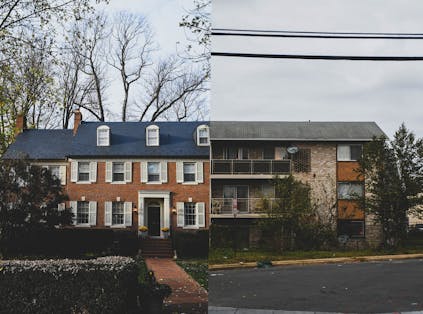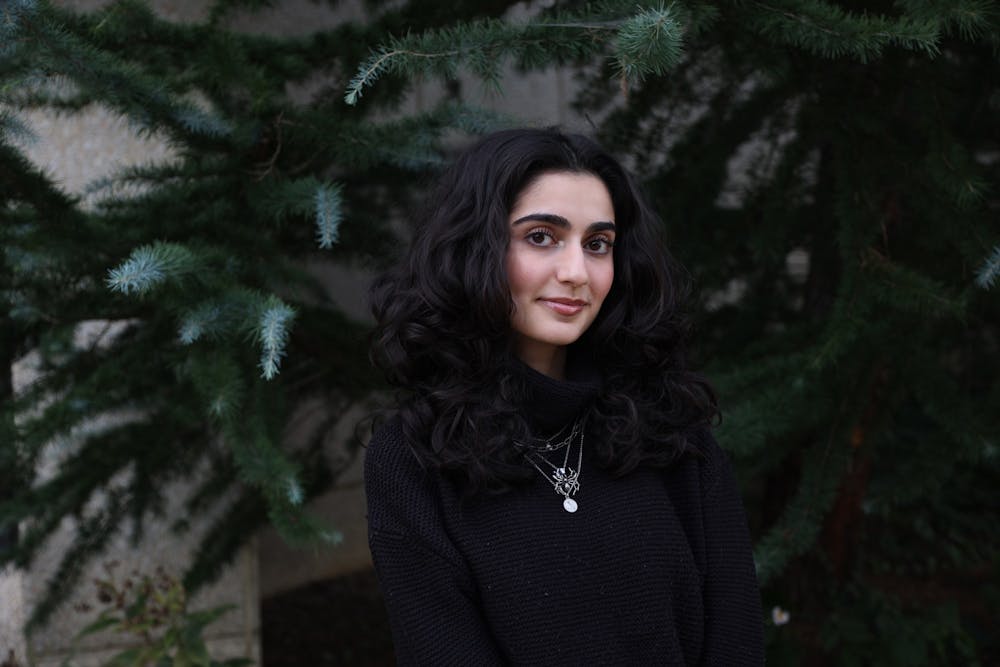From the Newsstands: This story appeared in The Eagle's November 2022 print edition. You can find the digital version here.
As move-in day approaches in late August each year, D.C. is bustling with energy and activity with new silhouettes appearing all around the district. Whether it’s an American University or Georgetown University student, the exhilarating journey to explore every part of the city begins. With annual traditions of drunken night monumenting and thrills of scavenger hunts and museum trips, the nation's capital welcomes novel faces as its history remains buried once again.
The year is 1957: D.C. becomes the first city with a Black population majority as it depicts a portrait of Black culture and perseverance. The year is now 2022: D.C.’s Black population goes down to 41 percent as the city faces the highest rate of displacement in the country. The nation’s “Chocolate City” perishes as the Anacostia River divides the city not just naturally but also racially and economically.
This is the tale of two cities.
To the west of Rock Creek Park, consisting mainly of Ward 3, are the wealthiest and most exclusive neighborhoods, as the zoning codes are put in place to shape up the white and affluent population. The property values are higher here than anywhere else, and it’s zoned for only singlefamily homes. AU’s campus resides here in Ward 3, where the ward population is 80 percent white. The average household income is $155,813.
To the east of Anacostia River, marked as a “low concentration zone,” where the population keeps increasing with no economic growth, is the most racially isolated part of D.C. 90 percent of the east-of-the-river neighborhoods are Black and at the most risk for displacement. The poverty rate is three times higher than in the rest of the city, and food insecurity is prevalent. The average household income for this part of D.C. is $34,000.
As a modern version of racial inequality, residential segregation serves to group people into neighborhoods and communities based on race while depriving them of access to good schools, nutritious foods, healthy environments, well-paying jobs and more. Unlike school desegregation, no deliberate, proactive effort was made to integrate neighborhoods, according to the Othering & Belonging Institute. Although the Fair Housing Act of 1968 prohibited discrimination in housing based on race and played a crucial role in assisting with integration, its role in the long run was not efficient.
The city’s growing diversity only meant one thing for Black homeowners: They would become strangers to their neighborhoods as their lifelong homes turned to ruins. As property values increased and property taxes skyrocketed, more than 20,000 Black D.C. residents were displaced between 2000 and 2013. According to an analysis by WUSA, pre-dominantly non-white neighborhoods in the lowest tax brackets had a property tax increase by three percent relative to income. Meanwhile, wealthy communities only faced a one percent increase since 2000. The gentrification tax placed on the vulnerable communities made leeway for displacement as D.C. poverty rates were on the rise, especially in the city’s segregated neighborhoods.
The exclusionary zoning laws made up the D.C. we know today: 23 percent of D.C.’s land area and 80 percent of land west of Rock Creek Park is restricted to detached single-family homes, where growth only takes place in a few areas of the city, putting the rest at stake. Not only are people pushed away from their homes, but they are also pushed away from transit after leaving a dense urban zone. Low income, Black residents who have not historically relied on a car are left vulnerable as a further resource is stolen from them.

One of the many communities gentrification targeted was the Shaw neighborhood, formerly known as the “Black Broadway.” This wasn’t your average neighborhood; it was the soul of Chocolate City. However, it didn’t matter to multimillion-dollar real estate agencies that the city birthed the Black Renaissance, or that it was the center of Black businesses, entertainment, religion and education in the District. As stated in the Jetset Times, the 90 percent Black community in the 1970s dropped to 30 percent in 2010. The median home price went up to $781,000 from $147,000. The $50,089 average family income was replaced by a $145,096 average income. Due to the influx of white newcomers, the Shaw neighborhood was dissipated, leading to the residential, cultural and political displacement of its people.
Spanning from 1950-1970, the Urban Renewal project in Southwest D.C. struck another blow to the district. The project was said to have a public health initiative and planned to get rid of alleyway homes and slums. According to an article in Story Maps, the 70 percent Black population in the region vanished; a $500 million budget cleansed 23,000 residents, 1,500 businesses and 6,000 families. The project failed to re-establish a sense of community in the region where it lacked commercial, entertainment and restaurant institutions. Although the program initially created substantial economic growth, it also contributed to urban inequality and the displacement of thousands and ultimately failed to create a long-lasting, economically prosperous community.
In 1950, President Harry S. Truman quoted, “Washington, D.C. should be the best-planned city in the world and a Capital befitting the dignity and ideals of a great nation in a family of nations.” Is this the D.C. he envisioned, representing the ideals of a great nation by turning its people into profit and replacing them with real estate deals?
D.C., the capital of the nation in all its glory and an opportunity hub for many college students who want to pursue a career in politics. D.C., the capital of the nation that has witnessed the displacement of thousands and watched its culture slowly fade away.
We can’t claim to love the city without its other half. We can’t claim to love the city without picking up the remnants of its abandoned history. We can’t claim to fight for human rights without lending a hand to communities that have been bleeding for decades.
Meliha Ural is a sophomore in the School of Public Affairs and School of Communication and a columnist for the Eagle.





